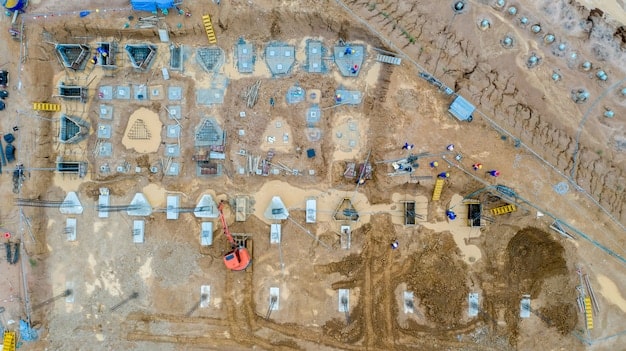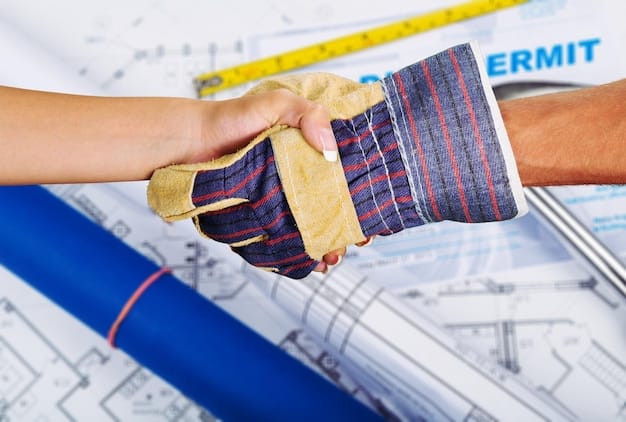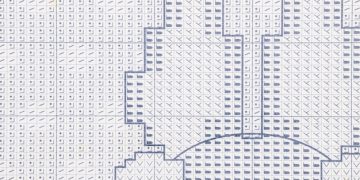US Construction Defect Claims: Avoid Costly Litigation in 2025

Anúncios
Navigating US Construction Defect Claims in 2025 requires proactive strategies, robust contract management, and rigorous quality control to circumvent expensive and time-consuming litigation, safeguarding project viability and stakeholder trust.
In the dynamic landscape of the construction industry, understanding and mitigating the risks associated with US Construction Defect Claims: How to Avoid Costly Litigation in 2025 is paramount. This guide provides an in-depth look at preventive measures and best practices to help stakeholders sidestep the financial and reputational pitfalls of legal disputes.
Understanding Construction Defects and Their Implications
Construction defects, often more complex than they initially appear, encompass a wide range of issues, from faulty materials to flawed design and substandard workmanship. These defects can manifest in various forms, including structural deficiencies, water intrusion, mechanical system failures, and code violations. Their implications extend far beyond mere inconvenience, potentially leading to significant financial losses, project delays, safety hazards, and damaged professional reputations. Identifying the root cause and implementing timely corrective actions are essential to avoid escalation and prevent costly legal battles.
The legal framework surrounding construction defect claims in the US is intricate, involving state-specific statutes of limitations, repose, and notice requirements. These legal nuances dictate when and how claims can be filed, making early detection and expert legal consultation critical for all parties involved, including developers, contractors, subcontractors, architects, and engineers. A single defect can trigger a ripple effect, impacting multiple trades and disciplines, which underscores the importance of a comprehensive understanding of potential liabilities.
Types of Construction Defects
Understanding the common categories of construction defects is the first step toward effective prevention. While the specifics can vary greatly, most defects fall into one of several primary classifications that highlight areas requiring heightened vigilance.
- Design Deficiencies: Issues stemming from errors or omissions in architectural or engineering plans, leading to structural instability or improper functionality.
- Material Defects: The use of substandard, faulty, or inappropriate building materials that fail prematurely or do not meet project specifications.
- Workmanship Errors: Flaws arising from improper installation, construction practices, or failure to adhere to industry standards and building codes.
- Subsurface Conditions: Problems related to soil instability, unforeseen geological issues, or inadequate foundation preparation that impact structural integrity.
Each type demands a unique approach to investigation, remediation, and legal strategy. For instance, design errors often point to the responsibility of the design professionals, whereas workmanship issues typically fall on the contractors or their subcontractors. The interconnectedness of these elements means a defect in one area can exacerbate problems in another, highlighting the importance of integrated project management and quality assurance across all phases.
To mitigate the impact of these defects, both technical and administrative processes must be robust. This includes implementing rigorous material testing, conducting frequent on-site inspections, and maintaining detailed documentation of all project activities. Proactive engagement with all project stakeholders, from concept to completion, helps ensure that potential issues are identified and addressed before they become costly defects. The financial burden of rectifying defects can be substantial, often involving demolition, reconstruction, and extensive legal fees, making prevention the most cost-effective approach.
Ultimately, a deep understanding of construction defects and their broad implications is foundational for anyone operating within the US construction industry. It enables stakeholders to develop more effective risk management strategies, implement superior quality control measures, and foster a collaborative environment aimed at delivering projects that are structurally sound, functionally efficient, and legally compliant.
Proactive Contract Management: Your First Line of Defense
Effective contract management is arguably the most critical proactive measure in avoiding construction defect claims. Before any ground is broken, the contractual agreements must clearly define roles, responsibilities, standards, and dispute resolution mechanisms. Vague or Ambiguous language can become fertile ground for disputes when problems arise, leading to prolonged and expensive litigation. A well-drafted contract serves as a binding blueprint for all project participants, outlining expectations and providing a clear path for accountability.
Beyond initial drafting, diligent contract administration throughout the project lifecycle is key. This involves meticulous record-keeping, tracking changes, and ensuring compliance with all agreed-upon terms. Any deviation from the contract should be formally documented and addressed, preventing minor discrepancies from evolving into significant legal challenges. Furthermore, incorporating provisions for alternative dispute resolution (ADR), such as mediation or arbitration, can provide a less adversarial and more efficient means of resolving disagreements before they escalate to full-blown lawsuits.

Key Contractual Provisions for Defect Prevention
Specific clauses within construction contracts can significantly bolster defenses against defect claims. These provisions should be carefully considered and tailored to each project’s unique characteristics and risks, ensuring comprehensive protection for all parties involved.
- Scope of Work Definition: Clearly delineates the exact responsibilities and deliverables of each party, minimizing potential misunderstandings regarding project parameters.
- Quality Standards and Specifications: Establishes measurable criteria for materials, workmanship, and performance, providing a benchmark against which work can be evaluated.
- Inspection and Acceptance Procedures: Outlines the process for reviewing and approving work at various stages, including opportunities for corrective action before defects become embedded.
- Warranty Provisions: Specifies the duration and scope of warranties for completed work and materials, detailing obligations for repair or replacement of defective elements.
- Indemnification Clauses: Allocates risk and responsibility for losses or damages arising from specific events, protecting parties from liabilities caused by others’ negligence.
- Notice Requirements: Defines the formal procedures and timelines for notifying parties of potential defects, ensuring timely communication and resolution efforts.
These provisions must be negotiated and understood by all stakeholders prior to project commencement. It is not enough to simply include them; their implications must be clear, and compliance must be enforced. Regular contract reviews and updates are also essential, especially for long-term projects, to reflect any changes in scope, schedule, or conditions. The goal is to create a robust contractual framework that anticipates potential issues and provides clear pathways for resolution, thereby reducing reliance on litigation as a primary recourse.
Moreover, including clauses that mandate professional training and certification for certain types of work can further minimize the risk of workmanship defects. Such provisions ensure that individuals performing specialized tasks possess the necessary skills and knowledge, adhering to industry best practices. When all parties operate under a clear, comprehensive, and enforceable contract, the likelihood of unexpected costly litigation stemming from construction defects is significantly reduced, fostering a more predictable and successful project environment for everyone involved.
Implementing Robust Quality Control and Assurance Programs
Beyond contractual precautions, the practical implementation of stringent quality control (QC) and quality assurance (QA) programs on-site is paramount. QC involves the systematic monitoring and evaluation of project activities to ensure that established performance standards are being met. This means regular inspections, testing of materials, and verification of compliance with design specifications and building codes. QA, on the other hand, is a broader, proactive approach focused on preventing defects by establishing systematic processes and procedures that ensure quality throughout the project lifecycle, from design to execution. Together, QC and QA form a formidable defense against potential defects.
Effective quality management isn’t just about catching errors; it’s about fostering a culture of quality where every team member understands their role in delivering excellence. This requires clear communication, ongoing training, and consistent reinforcement of quality standards. Investing in advanced technologies for monitoring and inspection, such as drones for site surveys or Building Information Modeling (BIM) for clash detection, can also significantly enhance the effectiveness of QC/QA efforts, identifying potential issues before they become embedded in the physical structure.
Key Elements of an Effective QC/QA Program
A comprehensive QC/QA program should integrate several critical components to ensure thorough oversight and continuous improvement across all project phases. These elements collectively contribute to a proactive approach to quality management.
- Detailed Quality Management Plan (QMP): A written document outlining specific quality objectives, inspection schedules, testing protocols, and roles/responsibilities for quality control.
- Regular On-site Inspections: Frequent, documented inspections by qualified personnel to verify compliance with plans, specifications, and building codes.
- Material Testing and Verification: Rigorous testing of all incoming materials to ensure they meet specified quality standards and are free from defects.
- Submittal and RFI Management: A structured process for reviewing and approving contractor submittals (e.g., shop drawings, material data) and responding to Requests for Information (RFIs) promptly to prevent mistakes due to lack of clarity.
- Performance and Compliance Audits: Periodic audits to assess the effectiveness of the QC/QA program itself and ensure adherence to established procedures.
Documentation is a cornerstone of any effective QC/QA program. Every inspection, test, meeting, and decision related to quality must be meticulously recorded. This documentation serves as crucial evidence in the event of a dispute, demonstrating due diligence and adherence to standards. Digital platforms and software solutions can streamline this process, ensuring data accuracy and accessibility. Furthermore, immediate corrective action for identified issues is vital. Delaying repairs or ignoring minor discrepancies can lead to more significant problems down the line, increasing both the cost and complexity of remediation.
Ultimately, a robust QC/QA program is an investment that pays dividends by reducing rework, avoiding delays, enhancing safety, and—most importantly—preventing costly construction defect claims. It transforms the approach from reactive problem-solving to proactive defect prevention, contributing to successful project delivery and maintaining a strong reputation in the competitive construction market. It fosters confidence among clients and stakeholders, solidifying long-term business relationships.
The Power of Thorough Documentation and Communication
In the construction industry, documentation is not merely a bureaucratic chore; it is an invaluable tool for risk management and dispute resolution. Every decision, communication, inspection, and change order should be meticulously recorded and easily accessible. When a construction defect claim arises, comprehensive documentation can be the difference between a successful defense and costly litigation. It provides an objective record of events, commitments, and performance, allowing parties to trace back issues and establish accountability with clarity and precision. From daily logs to extensive photo archives, these records paint a complete picture of the project’s evolution.
Equally important is clear, consistent, and formal communication among all project stakeholders. Misunderstandings often stem from informal agreements or vague instructions. All critical communications, whether related to design changes, site conditions, schedules, or quality issues, should be put in writing. This includes emails, meeting minutes, and official correspondence. Establishing a centralized communication platform can further enhance this process, ensuring that everyone has access to the most current information and that no critical message is overlooked or misinterpreted. Proactive communication helps identify potential issues early, allowing for collaborative problem-solving before they escalate into formal disputes.
Essential Documentation for Defect Defense
To effectively defend against construction defect claims, a comprehensive suite of documents must be maintained throughout the project. These records collectively establish a clear timeline and accountability trail.
- Contracts and Amendments: Signed agreements, change orders, and any official modifications to the original scope or terms.
- Blueprints and Design Documents: All approved architectural, structural, mechanical, electrical, and plumbing plans, including revisions.
- Permits and Approvals: Documentation of all necessary building permits and regulatory approvals.
- Daily Reports and Progress Logs: Records of daily activities, weather conditions, workforce, equipment, and any on-site issues or observations.
- Inspection Reports: Detailed records from quality control inspections, third-party testing, and jurisdictional approvals, including photographic evidence.
- Meeting Minutes: Notes from all project meetings, documenting decisions made, action items, and attendees.
- Correspondence: All formal communications, including emails, letters, and RFIs, between project parties.
The method of documentation storage is also critical. Digital solutions, such as cloud-based project management software, offer secure, searchable, and easily accessible repositories for all project information. This not only streamlines information retrieval but also provides an unalterable audit trail. Regular backups and version control are essential to ensure the integrity and availability of these records. Furthermore, establishing clear protocols for document retention after project completion is vital, as legal claims can arise years later, well within the statute of repose.
In essence, robust documentation and transparent communication are not merely administrative burdens; they are strategic assets that protect all parties involved in a construction project. They foster transparency, accountability, and a proactive approach to issue resolution, significantly reducing the likelihood and severity of construction defect claims. By investing time and resources into these practices, construction firms and developers can build not only structures but also strong legal defenses and lasting trust with their clients.
Navigating Legal Frameworks and Expert Engagement
Even with rigorous preventative measures, construction defect claims can sometimes arise. When they do, a thorough understanding of the US legal framework and the strategic engagement of legal and technical experts become indispensable. The legal landscape governing construction defects is complex, varying significantly from state to state concerning statutes of limitations, statutes of repose, notice requirements, and specific building codes. Navigating this labyrinth successfully requires specialized knowledge that extends beyond general legal practice. Early engagement with legal counsel specializing in construction law is crucial, allowing for timely action and informed decision-making.
Beyond legal expertise, technical experts play a pivotal role in assessing the validity and scope of a defect claim. Engineers, architects, and construction consultants can provide essential forensic analysis, determine root causes, quantify damages, and offer opinions on industry standards of care. Their objective assessments are critical for substantiating claims or defenses, often serving as the backbone of settlement negotiations or courtroom arguments. The synergy between legal and technical expertise is what allows parties to develop a robust strategy, whether it’s pursuing a claim or defending against one.
The Role of Expert Witnesses in Defect Litigation
Expert witnesses are crucial to the effective prosecution or defense of construction defect claims. Their specialized knowledge and ability to explain complex technical issues in an understandable manner can significantly influence the outcome of a case.

- Forensic Investigation: Experts conduct in-depth analyses to identify the presence, cause, and extent of defects, often involving destructive testing and material analysis.
- Standard of Care Assessment: They determine whether the work performed met the applicable professional and industry standards prevalent at the time of construction.
- Damage Calculation: Experts provide calculations of the cost to repair or replace defective work, as well as associated damages like loss of use or diminution in value.
- Testimony and Reports: They prepare detailed reports and provide expert testimony in depositions, hearings, and trials, translating technical jargon into accessible language for judges and juries.
Selecting the right experts is a strategic decision. They must possess not only deep technical knowledge and extensive experience but also credibility and the ability to articulate complex concepts clearly and persuasively. Their findings and opinions must be unbiased and based on sound scientific or engineering principles. Furthermore, understanding the interplay between different types of experts—for example, a structural engineer alongside a moisture intrusion specialist—is vital for a comprehensive assessment of multifaceted defects.
The engagement of experts should ideally occur early in the dispute process. This allows for a thorough investigation and evaluation of the claims before significant legal costs accumulate. Early expert analysis can help determine the strengths and weaknesses of a case, informing settlement discussions and litigation strategies. Ultimately, a proactive and informed approach to the legal aspects of construction defect claims, supported by the right technical and legal expertise, is essential for mitigating risks and achieving favorable outcomes in what can often be a highly contentious area of law.
Strategies for Resolution: Mediation, Arbitration, and Litigation
When construction defects lead to disputes, understanding the available resolution strategies is paramount. While litigation is often the first thought, it is typically the most expensive, time-consuming, and adversarial option. Fortunately, alternative dispute resolution (ADR) methods, primarily mediation and arbitration, offer more efficient and less confrontational pathways to resolution. These methods are increasingly incorporated into construction contracts as a mandatory first step, aiming to resolve issues before they escalate into formal court proceedings. Choosing the right strategy depends on the specifics of the dispute, the relationships between parties, and the desired outcome.
Mediation involves a neutral third party facilitating negotiations between disputing parties, helping them reach a mutually agreeable settlement. The mediator does not impose a decision but guides the conversation towards common ground. Arbitration, in contrast, is more formal, resembling a mini-trial where a neutral arbitrator or panel hears evidence and arguments from both sides and then renders a binding decision. Both ADR methods prioritize privacy and often result in quicker resolutions compared to the public and lengthy process of litigation. Litigation, though sometimes unavoidable, should be considered a last resort due to its high costs, unpredictable outcomes, and potential for damaging professional relationships.
Choosing the Right Dispute Resolution Method
The decision on how to resolve a construction defect claim should be a strategic one, considering various factors to achieve the most favorable and efficient outcome for all parties involved.
- Mediation: Suited for situations where parties are willing to compromise, value preserving relationships, and seek a flexible, confidential resolution. It’s effective for clarifying misunderstandings and exploring creative solutions.
- Arbitration: Preferred when parties want a binding decision but wish to avoid the formality, expense, and public nature of court. It offers a structured process with a neutral decision-maker and is often quicker than litigation.
- Litigation: Reserved for cases where ADR fails, significant legal precedents need to be set, or one party is unwilling to cooperate in alternative methods. It provides formal discovery processes and a definitive judicial ruling.
Each method has its unique advantages and disadvantages, and the suitability greatly depends on the specific circumstances of the defect claim. For instance, complex technical disputes might benefit from an arbitrator with a construction background, while simpler claims might resolve quickly through mediation. It’s also common for contracts to stipulate a multi-tiered approach, starting with negotiation, then mediation, followed by arbitration, and only then resorting to litigation if all prior attempts fail. This phased approach encourages early resolution and minimizes legal expenditures.
Regardless of the chosen method, preparation is key. This includes gathering all relevant documentation, organizing evidence, and clearly articulating the nature and extent of the defect. Engaging legal counsel early ensures that the chosen resolution strategy aligns with the overarching business objectives and legal rights of the party. By understanding and strategically utilizing mediation, arbitration, and litigation, construction professionals can navigate defect claims effectively, minimizing financial impact and preserving invaluable professional relationships within the industry.
Future-Proofing Your Projects: Beyond 2025
As the construction industry evolves, so too do the complexities of potential defect claims. Future-proofing projects involves anticipating emerging challenges and integrating forward-thinking strategies into every phase of construction. This goes beyond current best practices and delves into embracing technological advancements, adapting to evolving regulations, and fostering a culture of continuous improvement. The goal is to build not just for today but for a sustainable, resilient future, minimizing the likelihood of latent defects emerging years down the line. It demands a proactive mindset, where innovation and adaptability are as crucial as traditional construction expertise.
Embracing technologies like advanced analytics, predictive modeling, and blockchain for supply chain transparency can offer unprecedented data insights into construction processes, enabling early detection of potential issues. Similarly, staying abreast of changes in building codes, environmental regulations, and material science is critical. These shifts can introduce new compliance requirements or reveal unforeseen risks associated with novel materials or methods. Future-proofing also means investing in ongoing training for personnel to ensure they are equipped with the latest knowledge and skills, proactively reducing workmanship errors and promoting the highest standards of quality.
Emerging Trends and Risk Mitigation in Construction
The construction sector is dynamic, with various trends shaping its future. Recognizing these trends and their potential impact on defect claims is vital for proactive risk management and sustainable business practices.
- Sustainable and Green Building Practices: While beneficial, these often involve new materials and complex systems that may have unforeseen long-term performance issues if not properly implemented and maintained. Rigorous testing and certification become even more critical.
- Modular and Prefabricated Construction: Offers efficiency but introduces new defect risks related to transportation, assembly on-site, and the integration of diverse components manufactured off-site. Ensuring quality control across the entire supply chain is paramount.
- Increased Digitalization and BIM Integration: While BIM aids in clash detection and design coordination, errors in digital models can propagate through the entire project. Emphasizing data accuracy and interoperability is key.
- Workforce Skills Gap: A shortage of skilled labor can lead to increased workmanship errors. Investing in training, certification, and mentorship programs can help mitigate this risk.
- Climate Change Adaptation: Increased frequency of extreme weather events demands more resilient designs and materials. Defects related to water intrusion or structural integrity under severe conditions may become more common.
To navigate these emerging challenges, collaboration across the industry is essential—from developers and contractors to insurers, manufacturers, and regulators. Sharing knowledge, lessons learned, and best practices can help collectively raise the bar for quality and minimize the incidence of defects. Furthermore, fostering strong relationships with subcontractors and suppliers, ensuring they meet rigorous qualification standards and share commitments to quality, reduces downstream risks. The future of construction defect claims mitigation relies not only on individual project diligence but also on a collective industry effort to embrace innovation responsibly and prioritize long-term performance and resilience.
Ultimately, future-proofing projects is about building a robust and adaptable framework that anticipates and addresses potential vulnerabilities before they become costly liabilities. By continuously evaluating practices, integrating new technologies, and staying informed about industry shifts, construction professionals can significantly reduce exposure to defect claims and ensure the enduring success and reputation of their ventures well beyond 2025.
| Key Action | Brief Description |
|---|---|
| 📋 Proactive Contracts | Draft clear, detailed contracts defining roles, standards, and dispute resolution. |
| ✅ Robust QC/QA | Implement rigorous quality control and assurance programs on-site for early defect detection. |
| ✍️ Meticulous Documentation | Maintain comprehensive records of all project activities, communications, and inspections. |
| ⚖️ Expert Navigation | Engage legal and technical experts early to navigate complex legal frameworks and potential claims effectively. |
Frequently Asked Questions about Construction Defect Claims
A construction defect claim arises when a building or its components exhibit flaws in design, materials, or workmanship that deviate from specified standards, building codes, or industry practices. These defects can lead to structural damage, functional impairment, or safety hazards, often resulting in legal disputes over liability and necessary remediation costs.
Common types include design deficiencies, such as errors in architectural or engineering plans; material defects, involving the use of faulty or substandard products; and workmanship errors, like improper installation or failure to follow construction best practices. Water intrusion, structural issues, and mechanical system failures are frequent manifestations of these underlying problems.
To avoid litigation, contractors should implement meticulous contract management, ensuring clear scopes and quality standards. Establish robust quality control and assurance programs with regular inspections, and maintain thorough documentation of all project activities. Proactive communication and prompt resolution of minor issues are also critical in preventing disputes from escalating.
Contracts serve as the primary defensive tool. Well-drafted agreements clearly define responsibilities, quality benchmarks, and dispute resolution procedures, preventing ambiguity. Specific clauses concerning warranties, indemnification, and notice requirements pre-empt many potential disputes. Diligent contract administration throughout the project ensures adherence and provides a basis for accountability.
Legal counsel specializing in construction law and technical experts (like forensic engineers) should be engaged as early as possible once a potential defect is identified or a claim is threatened. Their early involvement is crucial for understanding legal frameworks, assessing the defect’s nature, mitigating further damage, and developing a strategic response, potentially avoiding full-scale litigation through ADR.
Conclusion
Navigating the complex landscape of construction defect claims in the US requires a multi-faceted and proactive approach from all stakeholders. From meticulously drafted contracts and robust quality control programs to comprehensive documentation and the strategic engagement of legal and technical experts, prevention remains the most effective and cost-efficient strategy. By embracing these best practices, industry professionals can significantly mitigate risks, avoid costly litigation, and foster a foundation of quality and trust that extends well beyond project completion. The commitment to excellence and continuous improvement is not just a safeguard against defects but a cornerstone for sustainable success in the dynamic construction sector.





